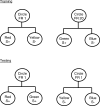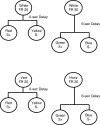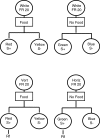Within-trial contrast: pigeons prefer conditioned reinforcers that follow a relatively more rather than a less aversive event
- PMID: 17725056
- PMCID: PMC1918080
- DOI: 10.1901/jeab.2007.27-06
Within-trial contrast: pigeons prefer conditioned reinforcers that follow a relatively more rather than a less aversive event
Abstract
When behavior suggests that the value of a reinforcer depends inversely on the value of the events that precede or follow it, the behavior has been described as a contrast effect. Three major forms of contrast have been studied: incentive contrast, in which a downward (or upward) shift in the magnitude of reinforcement produces a relatively stronger downward (or upward) shift in the vigor of a response; anticipatory contrast, in which a forthcoming improvement in reinforcement results in a relative reduction in consummatory response; and behavioral contrast, in which a decrease in the probability of reinforcement in one component of a multiple schedule results in an increase in responding in an unchanged component of the schedule. Here we discuss a possible fourth kind of contrast that we call within-trial contrast because within a discrete trial, the relative value of an event has an inverse effect on the relative value of the reinforcer that follows. We show that greater effort, longer delay to reinforcement, or the absence of food all result in an increase in the preference for positive discriminative stimuli that follow (relative to less effort, shorter delay, or the presence of food). We further distinguish this within-trial contrast effect from the effects of delay reduction. A general model of this form of contrast is proposed in which the value of a primary or conditioned reinforcer depends on the change in value from the value of the event that precedes it.
Figures










References
-
- Amsel A. The role of frustrative nonreward in noncontinuous reward situations. Psychological Bulletin. 1958;55:102–119. - PubMed
-
- Armus H.L. Effects of response effort on secondary reward value. Psychological Reports. 1999;84:323–328.
-
- Armus H.L. Effect of response effort on the reward value of distinctively flavored food pellets. Psychological Reports. 2001;88:1031–1034. - PubMed
-
- Aronson E, Carlsmith J.M. Effects of severity of threat in the devaluation of forbidden behavior. Journal of Abnormal and Social Psychology. 1963;66:584–588.
-
- Aronson E, Mills J. The effect of severity of initiation on liking for a group. Journal of Abnormal and Social Psychology. 1959;59:177–181. - PubMed
Publication types
MeSH terms
Grants and funding
LinkOut - more resources
Full Text Sources
Miscellaneous

